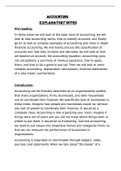Interview
Introduction into Accounting Basics
- Course
- Institution
- Book
This document, will let you see accounting in a different light. It will explain the basics thoroughly and show you how to apply the basics to complex problems. Sometimes out teachers and tutors innocently skip over the basics , which causes problems in more complex accountancy. This is essentiall...
[Show more]




